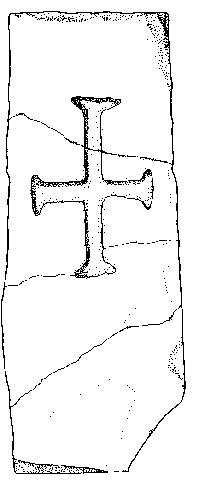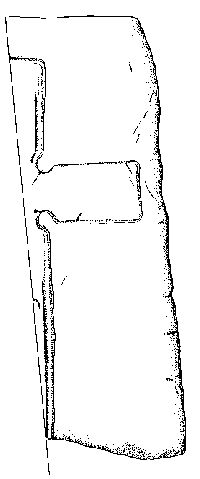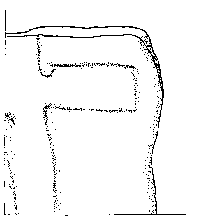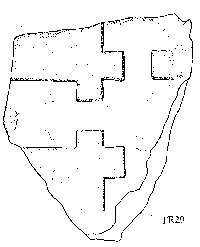 Bulletin
2, 1996
Bulletin
2, 1996
Discovery of New Sculpture
[Figs. 10, 11, 12, 13 and see Sculpture Catalogue for an updated inventory of sculpture from Tarbat]
Cross-slab, TR20 The "Monk Stone"
Figure 9: TR20, "Monk Stone".
Face 1 (left) and face2 (right) drawn by Elizabeth Hooper and Juliet Reeves,
and reconstruction by Elizabeth Hooper.
The "Monk Stone" was first seen in 1995 by Niall Robertson in the south wall of the crypt vault. The approximate form of part of its decoration was recorded, largely by feel, while the stone was still in the wall, and an outline drawing published in Bulletin 1, p 15, fig 8. The stone was removed from the crypt wall in 1997 with the assistance of Fred Geddes, project architect, and Mark Eliot, conservator, Inverness Museum. A report on the extraction will appear in Bull 3 together with the interim report on the Church excavations.
The stone, measuring 710 x 410 x 178mm thick, is of good quality dense sandstone and carried evidence of having been used in at least two buildings, one using white mortar and the other (the vault) using brown clay bonding. The stone has two decorated faces, and has been cut across diagonally, apparently to suit an architectural purpose. The short edge is rough, showing that the stone comes from a wider, as well as a longer monument, an idea which is of course endorsed by the scheme of decoration. There were traces of black colouration (paint?) on face 1.
Face 1: The upper register is a panel of spiral ornament, with below it a rampant beast with spiral limb joints, gaping fanged mouth and protruding tongue. The animal's tail is looped and terminates in a lump, itself resembling a snake head. The feet are apparently ankled and single-toed, resembling those of a bird. This composite dragon-like creature is arranged over the peak of a rectangular panel containing symmetrical spirals with triangular terminals within the peak. This lower spiral panel is embraced by a turning rib of stone, which, if circular, implies an original monument at least 1m broad. Elizabeth Hooper's reconstruction reproduced in Fig 10 shows how these elements might have been composed to form a large cross.
As noticed by Joanna Close-Brooks (pers. comm.), this unusual form of diagonal panel is exactly replicated in the side of the Tarbat inscribed stone, TR13, which most probably formed part of the same monument.
Face 2: In the upper register, two animals, of lion-like aspect, confront each other. Between their fore paws lies the half-carcass of a deer. The deer is represented as neatly cut, the half-carcass balancing in an unrealistically vertical poise. To the top right is a slouching animal which may be intended as a bear. In the panel below are parts of four humans, face-frontal with ribbed clothing in low relief. The most right-hand person carries a book, and the figures are probably intended as clerics. The reconstruction suggests that there is room for 13 such figures, in which case they may signify the twelve apostles and Christ. A small element of decoration in a lower register, right, suggests that a panel of interlace or spriral work was below the clerics.
The affiliations of this stone are still being studied, but it is close to the Shandwick stone in its mode of rendering spirals and animals, and may have originally been a stone of similar size and grandeur. Together with Shandwick, Nigg and Hilton of Cadboll, the restored Tarbat cross-slab presents an exceptional flourishing of sculpture in Easter Ross at a date probably in the early 9th century, when the area was coming under pressure from both Scottish and Scandinavian forces. It is not impossible that other Tarbat fragments will be shown to have belonged to this great monument.
Grave-marker, TR21
|
|
|
|
Figure 10: Incised crosses, TR21, TR30, TR31 and fragment of cross in shallow
relief, TR29.
(Drawn by James Brennan).
A slab measuring 510 x 195 x 45mm thick, bearing an incised cross on its upper surface was discovered mortared into the wall Int17/F2 which was excavated beneath the partition separating the nave from the North aisle [Fig 7]. The cross is double-outlined and of a plain form between Allen and Anderson's Cross with round hollow angles (No. 101A; equivalent to Cramp 11) and Cross with parabolic hollow angles (No. 106A).
The dating of the piece is not likely to be precise. The form of a cross with round hollow angles is a common type in Scotland, with local examples from Lothbeg, Golspie, Shandwick, Wester Delnies, Brodie and Drainie. Those from Golspie, Shandwick and Wester Delnies are however in a highly ornamental relief. Plainer incised crosses with double-outlining are found among the re-used memorials at Govan (ECMS 7,13,34,35). The simple standing slab with incised geometric cross is known from grave-markers in early Northumbria (for example Hartlepool) and the form is adapted as the motif for carpet-pages in the Lindisfarne Gospels. The form was also employed in early Irish sites.
On its under side TR21 carries another cross with triangular terminals which do not reach to the edge on the stone.
TR30 and TR31 [Fig 10] are fragments of similar cross-slabs which were discovered in the foundations of the south wall of the church. They have been left in situ.
Recumbent slab, TR22 The "Boar Stone&qout; [Fig. 11]
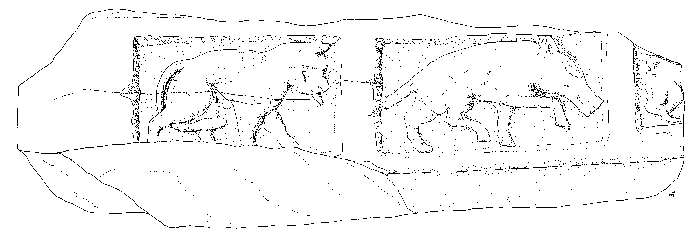
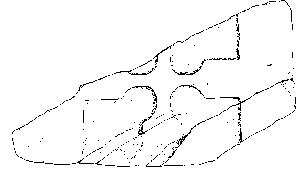
Figure 11: "Boar Stone", face 1 and 2.
Drawn by Elizabeth Hooper and James Brennan
The "Boar Stone" TR22 was discovered in the medieval wall-foundation, Int17/F2, incorporated in the third course down, 1.5 m from the east end of the wall where it ran beneath the east wall of the north aisle [Fig 7]. When in situ, the visible face of the stone looked north; it measures 1065 x 250mm. This face is divided into two panels with the beginning of a third where the stone was broken at its south end. Both surviving panels carry animals carved in relief, upside down with respect to their position when found.
When removed, the stone was found to be 460mm wide, and the hidden side was smooth, suggesting it was complete in width. The unbroken short end was carved with a cross of Allen and Anderson type 101. The underside carried part of a groove or seating. In its original setting the stone would have been a long slab set horizontally with the animals in their panels loping along from right to left, the groove downwards, and the cross set upright at the end. Such pieces could derive from architectural sculpture, but this example is most probably the lid of a sarcophagus, originally seated on a stone coffin.
One of the animals in question is intended as a boar, since it has a humped back and square snout; but the tail and movement make the identification less than totally convincing. The other is a quadruped which probably derives from a lion motif. The 'boar' panel measures 338 x 180mm and the 'lion' panel measures 306 x 180mm. Horizontally-viewed animals in relief are represented on Class 3 stones at Meigle (ECMS nos 9, 12 and 22) where the identifiable animals include bulls, a stag and a possible lion. Abercromby (Fife) no 4 carries a lion and possibly a boar. Bressay on Shetland has a piece which features a boar and a lion together beneath two clerics and a rider. Nearer home, there is lion on the Shandwick stone, and at Tarbat itself, TR1 includes animals in relief resembling lions on faces 1 and 2.
The wild boar has an even longer history as a symbol in the region, since it is incised on Class I stones provenanced at Knocknagael and Dores, Clune Farm, both near Inverness.
Trial piece, TR28 The "Calf Stone"

Figure 12: TR28, "Calf Stone".
Drawn by Elizabeth Hooper.
This large piece of sculpture was discovered in the Glebe Field excavations in 1997. It measures 720 x 480 x 100mm thick and is formed from old red sandstone with pebble inclusions, such as may be found among the rocks on the beach at Portmahomack. Only one side of the fragment is worked and that incompletely. The lower register is only partially cut, and the tool-marks may be seen. The upper register is cut in low relief, and features a cow, a bull, (or perhaps a larger cow) with a calf between them. The larger of the two cattle is licking the calf. The parent animals are rendered with spiral joints which resemble those on the Burghead bulls, although the Burghead animals are far more robust and heavy shouldered. The cow on the stone from Inverness (ECMS , 103) is done in a very similar way to the Tarbat cattle.
The affiliations of the "calf stone" might suggest that it was early, say 7th century; but this need not be so. The Inverness and Burghead pieces are nominally Class I, but do not carry Pictish symbols as such, only single animals. Even if the symbol stones themselves are reckoned to be a first phase of stone carving, to be followed at a later date by the production of Class II, with their Christian emblems, there is no certainty that the single animal stones of Inverness and locality should be included among them. Above the cattle may be seen the lower part of a rider with a spear on a rearing horse; while below left is the head of what might be a sheep. Such as they are, these motifs would be more at home in the repertoire of Class II or Class III than Class I carvings.
The rebated spaces between the legs of the animals have not been flattened, but bulge up, adding to the impression that the piece is unfinished. The subject matter, of miscellaneous animals, while not determinant in itself, is also a pointer that this might have been a trial piece. Given the indications on offer, it would be rash to insist on a dating more precise than 7-9th century for the "calf stone".
Fragment of Cross in low relief, TR29 [fig 10]
The cross (ECMS type 98) is of stepped form and executed in low relief . The fragment is discontinuous on all sides. It measures 325 x 720mm, and was found bonded into the top of the west wall of the crypt.
The Tarbat sculpture as a whole does not include any certain Class I productions, and the only one, TR1, which has Pictish symbols, is closely parallelled by Hilton of Cadboll. The inscription, TR13, is placed in the second half of the 8th century (Bull 1). The material at present is best placed in the 8-9th century, and all may in fact all belong to a dazzling episode around 800AD.
NEXT: Project Design
BACK: Evaluation Results
Last updated 10 October, 2003.
Contact the Tarbat Discovery Programme





